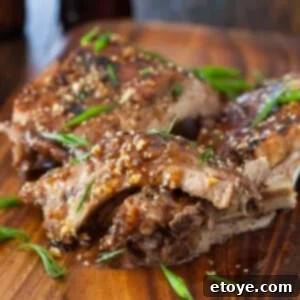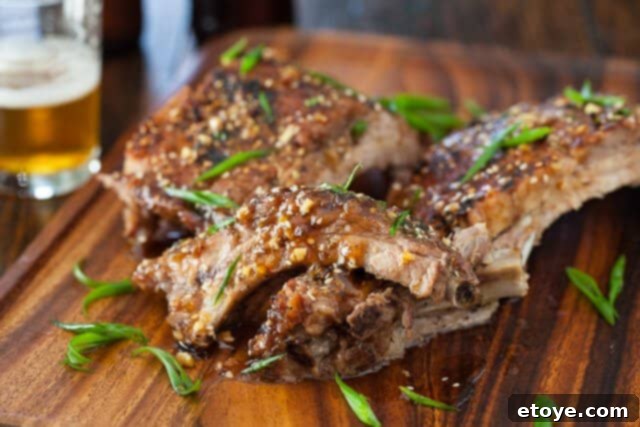Mouthwatering Korean Kalbi Baby Back Ribs: Your Ultimate Homemade BBQ Guide
There’s an undeniable allure to Korean barbecue – the sizzling meats, the vibrant array of side dishes (banchan), and the lively atmosphere that transforms a meal into an experience. However, for many, a good Korean BBQ restaurant isn’t always around the corner. Imagine craving those perfectly grilled, sweet, and savory Kalbi ribs, only to realize the nearest authentic spot is over an hour’s drive away. That distance becomes even more prohibitive when you consider the traditional accompaniments: ice-cold OB beer and sips of chilled soju, Korea’s iconic rice alcohol.
This is precisely why mastering homemade Korean cuisine becomes not just a culinary skill, but a necessity for those who yearn for these incredible flavors. While recreating the full restaurant ambiance might be a challenge, bringing the unforgettable taste of Korean BBQ into your kitchen is entirely achievable. And today, we’re diving deep into one of its most cherished dishes: Kalbi.
Understanding Kalbi: The Heart of Korean BBQ
When most people think of Korean BBQ, Bulgogi often comes to mind first. This popular dish features thinly shaved slices of rib-eye beef, tenderized and marinated in a flavorful blend of soy sauce, brown sugar, garlic, and sesame oil. It’s famously delicious, but Kalbi (sometimes spelled Galbi) offers a different, equally captivating experience. Kalbi traditionally refers to thinly sliced bone-in beef short ribs, marinated in a very similar, albeit often richer and more complex, sauce. Both dishes are traditionally cooked over an open flame, typically hot charcoal set right in the middle of the dining table, allowing each diner to grill their own meat to perfection.
The magic of Kalbi lies in its balance of sweet and savory notes, combined with the slight chewiness of the rib meat. The bone-in cut adds depth of flavor, making it a truly satisfying dish. While beef short ribs are the classic choice, home cooks often face challenges finding them pre-sliced or in the correct thickness, which can be tricky to prepare for an authentic BBQ experience.
Innovating with Pork Baby Back Ribs: A Home Cook’s Secret Weapon
My local grocery store, like many, doesn’t always carry the specific bone-in beef short ribs cut ideal for traditional Kalbi. The regular beef short ribs available are often too chunky and thick, making them less enjoyable to eat by hand and challenging to infuse with the marinade properly. This led to a delicious adaptation: using pork baby back ribs. And let me tell you, it’s a game-changer!
Baby back ribs are naturally tender, incredibly flavorful, and perfectly sized for individual portions. Their leaner meat still absorbs the marinade beautifully, resulting in a succulent, fall-off-the-bone texture that rivals the traditional beef version. This substitution not only solves the issue of availability but also makes the entire cooking process simpler and more accessible for everyday kitchens. Plus, who can resist a perfectly cooked, tender pork rib?
From Charcoal to Oven: Mastering the Art of Oven-Baked Kalbi
While the idea of carving out the middle of your dining table for a charcoal grill sounds fun, it’s hardly practical for most home settings. That’s why the oven becomes our best friend in this Korean BBQ adventure. Cooking Kalbi baby back ribs in the oven provides consistent heat, ensures even cooking, and, perhaps most importantly, minimizes mess. It transforms a potentially smoke-filled endeavor into a relaxed, hands-off process.
The oven method involves a two-stage cooking approach that guarantees maximum tenderness and flavor. First, the ribs are slow-baked, wrapped in foil, to achieve that incredibly tender texture. This essentially steams the ribs in their own juices, breaking down tough connective tissues. The second stage, a quick broil, is where the magic happens. After being slathered with that rich Kalbi marinade, the ribs are exposed to high heat, allowing the sugars in the sauce to caramelize and create a sticky, glossy, irresistible crust. This caramelization is key to achieving that authentic Korean BBQ char and depth of flavor without needing an actual grill.
To keep your oven (and your sanity) clean, a simple trick is to use a roasting pan that’s at least 2 inches tall and line it generously with aluminum foil. This clever setup traps all the flavorful juices with the ribs during baking, preventing them from dripping and burning onto the bottom of your oven. It’s a small step that makes a huge difference in cleanup!
The Iconic Kalbi Marinade: A Symphony of Flavors
The heart of any good Kalbi recipe is its marinade. This complex blend of ingredients creates the signature sweet, savory, and umami-rich flavor that makes these ribs so addictive. Our marinade for these baby back ribs incorporates essential Korean flavor profiles:
- Soy Sauce: The foundation, providing deep umami and salinity.
- Brown Sugar & Honey: Essential for sweetness and, crucially, for caramelizing beautifully under the broiler, creating that desired sticky glaze.
- Grated Onion, Minced Garlic, & Fresh Ginger: The aromatic trifecta that adds pungent, zesty, and spicy notes, infusing the meat with incredible freshness. Grating the onion helps release its juices and integrate seamlessly into the marinade.
- Sesame Seeds & Dark Sesame Oil: These contribute a distinct nutty aroma and flavor, a hallmark of Korean cuisine.
- Rice Vinegar: A touch of acidity balances the sweetness and savory elements, brightening the overall flavor profile. White or cider vinegar can be used as a substitute if rice vinegar isn’t available.
- Green Onion: Added for a mild, fresh oniony kick and a pop of color, especially when garnished.
This combination ensures every bite of your Kalbi ribs is packed with that authentic Korean BBQ taste you crave.
Serving Your Homemade Korean Kalbi Ribs
These Korean Kalbi Baby Back Ribs are fantastic on their own, but to truly elevate your meal to a full Korean BBQ experience, consider pairing them with traditional side dishes. Steamed white rice is a must, perfect for soaking up any extra sauce. A generous serving of kimchi, with its spicy, fermented tang, provides a wonderful contrast to the rich ribs. Other excellent banchan options include pickled radishes, quick cucumber salads, or even a simple fresh green salad dressed with a sesame-ginger vinaigrette. Don’t forget those cold beverages – whether it’s an icy beer or a shot of soju, they perfectly complement the bold flavors of the ribs.
Korean Kalbi Baby Back Ribs Recipe Video
Korean Kalbi Baby Back Ribs

Prep Time: 10 mins
Cook Time: 1 hr 35 mins
Servings: 4 – 6
Ingredients
- 6-7 pounds baby back ribs
- Salt & freshly ground black pepper
- 1/2 onion, grated
- 3 cloves garlic, finely minced
- 2 teaspoon grated fresh ginger
- 2 tablespoons honey
- 1/4 cup brown sugar
- 1/4 cup soy sauce
- 1 tablespoon sesame seeds
- 1 teaspoon dark sesame oil
- 1 stalk green onion, chopped
- 2 tablespoons rice vinegar (or white/cider vinegar)
Instructions
- Preheat oven to 375°F (190°C).
- (Optional, but highly recommended) Using a butter knife to pry it up, carefully separate and remove the membrane from the back of the ribs and discard. This step ensures incredibly tender ribs.
- Generously season both sides of the ribs with salt and pepper. Wrap the ribs tightly in foil, meaty side up, ensuring they are completely sealed to trap moisture.
- Bake for 90 minutes.
- While the ribs are baking, prepare the Korean Kalbi sauce: In a bowl, thoroughly mix together the grated onion, minced garlic, grated fresh ginger, honey, brown sugar, soy sauce, sesame seeds, dark sesame oil, chopped green onion, and rice vinegar.
- After the ribs have baked for 90 minutes, carefully remove them from the oven. Gently open up the foil (be very careful of the hot steam!).
- Slather approximately 3/4 of the prepared Korean Kalbi sauce evenly over the tops of the ribs.
- Move the oven rack to the top third of the oven and switch the oven setting to broiler (high heat).
- Place the ribs back in the oven, with the foil still open. Broil for about 3-5 minutes, or until the sauce begins to bubble, caramelize, and develop a slight char. Keep a very close watch on the ribs during this stage, as they can burn quickly.
- Just before serving, pour the remaining Korean Kalbi sauce over the ribs for an extra burst of fresh flavor. Serve hot and enjoy!
